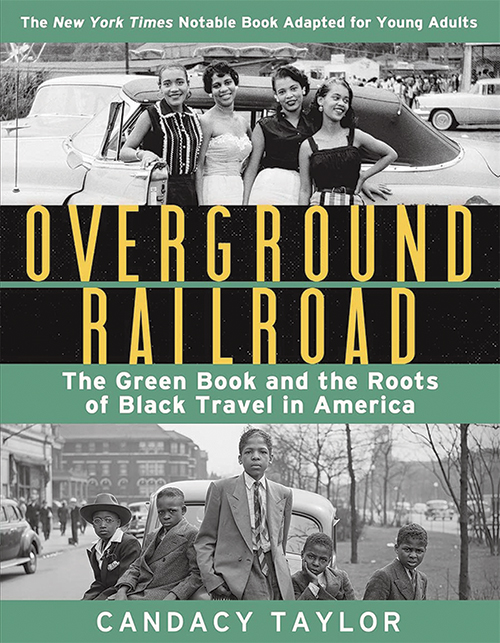
Overground Railroad: The Green Book and the Roots of Black Travel in America (The Young Adult Adaptation)
Reviewed by Paul Buckley
December 1, 2022
By Candacy Taylor. Amulet Books, 2022. 272 pages. $22.99/hardcover; $18.65/eBook. Recommended for ages 12 and up.
Jim Crow was a reality in my lifetime. This stubborn fact kept coming back to me as I read this book. Things I took for granted were legally denied to Black citizens, but this was not in any way part of my experience. I grew up in green, suburban neighborhoods; running with my friends; and blissfully unaware of how my country treated so many who did not enjoy our privileges and freedoms. I was naïve: totally unaware of pervasive racial oppression and an ever-present threat of violence that lay just below the surface, waiting to burst forth against children who didn’t look like me. Reading this book made it clear that my ignorance was part of the plan; it made me complicit.
This book is about the Green Book: one annual traveler’s guidebook but so much more. It is the story of a lost civilization: one that deserves to be lost but never forgotten. It tells the story of Black resistance to White repression, harassment, and tyranny. It tells about a subversive project: one that was designed to subvert Jim Crow but also contributed to the subversion of legal segregation and the denial of basic civil rights. It was a project, however, that ultimately subverted the Black economy and the Black community.
In 1936, Victor Hugo Green began publishing The Negro Motorist Green Book. It was not a new idea; there were already other guides for “Negro” and “Colored” travelers, but these had limited circulation and impact. Over nearly 30 years, the Green Book grew from a handful of pages into a comprehensive handbook. In its time, it listed more than 9,500 small businesses that served Black consumers: not just hotels, restaurants, and gas stations but also department stores, tailors, nightclubs, drugstores, hair salons, funeral homes, and real estate offices—even a dude ranch.
The Green Book directed a lot of trade to Black-owned and Black-friendly businesses, but it was more than a guide to goods and services. It directed Black people to establishments that would treat them with dignity.
While a “Whites Only” sign warned people away in some instances, too often there was no such blatant display. The absence of such a sign offered no guarantees, and its removal didn’t promise a welcome. In so many cases, “just because the sign was changed, the people who put it there hadn’t [changed].” Most often, no sign was posted in the window, leaving Black patrons to guess. Even in Victor Green’s hometown, New York City, “[t]he rules for segregated establishments changed from block to block, so Black people didn’t know where they would be served.”
The refusal of many White businesses to serve Black customers had a side effect: Black people had to depend upon each other. When the Green Book directed Black consumers to Black-owned stores, it not only helped them avoid confrontation and humiliation, it facilitated a sense of unity in the Black community. But this was to change.
The increasing numbers of White-owned, Black-friendly businesses in the Green Book document racial progress; there were big and small changes in the tumultuous middle decades of the twentieth century. These were record-expanding opportunities for Black consumers, as establishments that were previously off-limits opened their doors; it was, however, a mixed blessing. “In less than a decade after the passage of the Civil Rights Act [in 1964], at least half the Green Book Black-owned businesses were closed.” White-owned businesses benefited from new Black dollars coming in, but for many Black neighborhoods, the cost was devastating. More than 50 years later, Candacy Taylor attempted to find businesses that had been listed. Driving nearly 40,000 miles, she “passed miles of boarded-up buildings . . . seeing communities decimated by poverty, crime, and destructive government policies.” Taylor reports her frustration and furor at the conditions: “I would think the whole point of the Green Book was to keep Black motorists safe on the road, but it’s eighty years later and I can’t find a safe place to use the bathroom.”
The writing in this book is pitched to teens and young adults: an audience that can benefit from it greatly. It is an unfortunate characteristic of human creatures to imagine that the world before our births was not so different from our own. When we consequently underestimate the degree of change that took place in the past, it makes further change harder to envision. Overground Railroad paints an indelible portrait of progress that younger generations need to know.
But remember what I said above: I was an incredibly oblivious high schooler and young adult. There was so much I didn’t know, and I didn’t know that I didn’t know. Moreover, I have forgotten much of what I did know. But it isn’t just me. The world we live in was designed to “protect” White people from the truth. We older folks need reminding.
Buy this book for yourself and for others. Read it to dispel your own ignorance and to remind yourself of how much positive change we have lived through. Give it to younger people to fill in the gaps in their education. Tell the adult book group at your church or Quaker meeting. If we don’t know where we came from, we won’t know how far we still can go.
Paul Buckley worships with Clear Creek Meeting in Richmond, Ind. His most recent book is Primitive Quakerism Revived: Living as Friends in the Twenty-First Century.



Comments on Friendsjournal.org may be used in the Forum of the print magazine and may be edited for length and clarity.